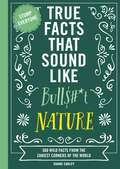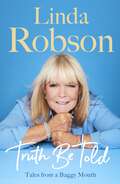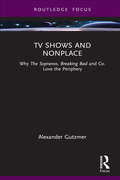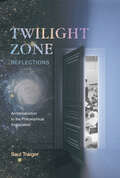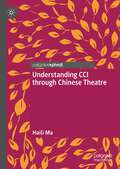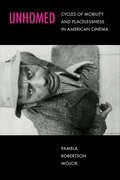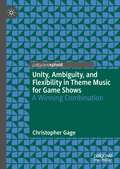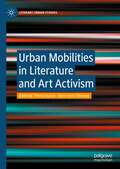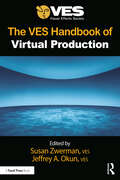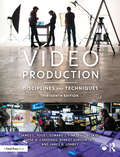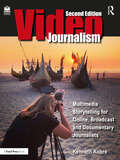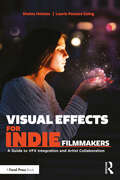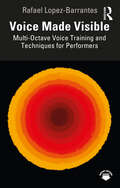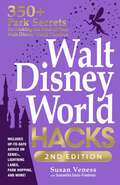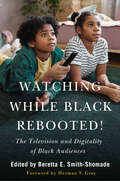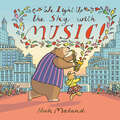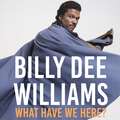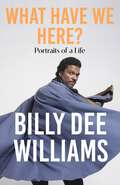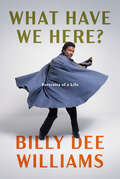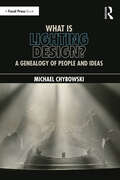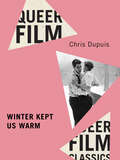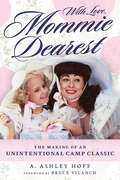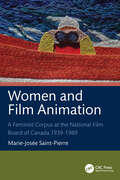- Table View
- List View
True Facts That Sound Like Bull$#*t: 500 Wild Facts from the Zaniest Corners of the World
by Shane CarleyGet ready to be bamboozled by nature&’s most bizarre, hilarious, and utterly astonishing secrets that will make you say, "Bull$#*t!"Say hello to the astonishing natural world with this mind-boggling collection of downright unbelievable facts that will have you doing double-takes at every turn. This captivating compendium is your ticket to exploring the wackiest secrets Mother Nature has up her sleeve. From the outrageous mating rituals of exotic creatures to the perplexing phenomena of Earth's wildest landscapes, True Facts That Sound Like Bull$#*t: Nature covers a vast array of topics that will leave you questioning everything you thought you knew about our planet. Each fact has been researched and verified, ensuring that even the most skeptical readers will be left in awe. Perfect for trivia buffs, nature enthusiasts, and anyone who loves a good laugh, this engaging and entertaining book is an incredible addition to your library.Inside you&’ll find facts like:The world&’s largest living organism is a mushroom that covers over 2,200 acres in Oregon.A single mature oak tree can drop up to 200,000 leaves in the fall.As a defense mechanism, some sea cucumbers expel their internal organs along with a toxic substance to deter predators. They can regenerate the lost organs within a few weeks.The tongue of a blue whale can weigh as much as an elephant.Vultures have stomach acid so strong that it can dissolve metal and kill harmful bacteria found in their carrion meals.Buckle up and prepare for a wild ride through the most fascinating, outlandish, and utterly mind-blowing corners of the natural world. You'll never look at nature the same way again!
Truth Be Told: Tales from a Baggy Mouth
by Linda RobsonTHE SUNDAY TIMES BESTSELLING HILARIOUS AND HEARTFELT MEMOIR FROM LINDA ROBSON__________Linda Robson’s nickname is Baggy Mouth for good reason.She may be one of the nation’s favourite TV personalities – whether playing Tracey Stubbs in Birds of a Feather or being a regular on Loose Women – but she can’t help hilariously oversharing. Luckily, this is an ideal trait for her first-ever memoir . . .Taking us back to the very beginning, growing up in a North London council house, Linda explains how she came to attend theatre school aged nine, where she met Pauline Quirke.As their friendship blossomed and evolved into a professional partnership, small parts in theatre and film productions culminated in the pair being cast in the enduring and beloved sitcom Birds of a Feather.With a wicked glint in her eye, Linda recounts the twists and turns of an actor’s life, sharing tales of backstage antics, on-set stories and demanding co-stars from across her her varied and celebrated career.However, it has not all been laughter, and she candidly talks about the struggles she’s faced in her personal life and the battles she has had to overcome. Yet her determination to pull herself back from the brink shows us that the tough times really do make us stronger.Truth Be Told is funny, warm and loose-lipped about a remarkable life well-lived.__________PRAISE FOR TRUTH BE TOLD'Searingly honest' The Mail
TV Shows and Nonplace: Why The Sopranos, Breaking Bad and Co. Love the Periphery (Routledge Focus on Television Studies)
by Alexander GutzmerThis book scrutinizes the relationship between contemporary TV shows and space, focusing on the ways in which these shows use and narrate specific spatial structures, namely, spaces far away from traditional metropolises. Beginning with the observation that many shows are set in specific spatial settings, referred to in the book as “nonplace territories” – e.g., North Jersey, New Mexico, or rural and suburban Western Germany – the author argues that the link between such nonplace territories and shows such as The Sopranos, Breaking Bad, or Dark is so intense because the narrative structure functions similarly to these territories: flat, decentralized, without any sense of structure or stable hierarchy. The book takes three different perspectives: first, it looks at the rationale for combining TV shows and nonplace territories from the viewpoint of narrative strategy. It then thinks through what these strategies mean for practicing architects. Finally, it approaches the arguments made before from a “user” perspective: what does this narrative mirroring of social-spatial reality in places such as Albuquerque or Jersey City mean for people living in these places? This new approach to architecture and space on screen will interest scholars and students of television studies, screen architecture, media and architectural theory, and popular culture.
Twilight Zone Reflections: An Introduction to the Philosophical Imagination
by Saul TraigerTwilight Zone Reflections is the first book of its kind to explore the entirety of The Twilight Zone (1959–1964) as a series. It acts as both an introduction to the field of philosophy and as a complete guide to the philosophical issues illustrated throughout the original 1959-64 television series. Author Saul Traiger explores each of the 156 episodes, investigating the show’s themes in metaphysics, epistemology, moral and political philosophy, and other topics in a way that is accessible to both seasoned philosophers and those outside academia. Each short chapter dives into a single episode and concludes with helpful cross-references to other episodes that explore similar philosophical problems and subjects. For example, a reader may be interested in questions about the nature of the mind and whether machines can think. By referencing this book, they could easily discover the thematic connections between episodes like “I Sing the Body Electric” or “The Lateness of the Hour,” and learn how both episodes introduce the viewer to possible worlds that challenge us to consider whether our idea of the mind, and even our very personhood, extends beyond the human to robots and other artificial intelligences. Each chapter introduces fundamental philosophical questions such as these through the lens of The Twilight Zone and inspires additional exploration. Further readings are suggested for all episodes, making this volume indispensable to academics, students, and fans of the show. Each chapter is short and accessible, ensuring that this book is the perfect resource to accompany a complete series re-watch. The Twilight Zone considered questions that strike at the heart of philosophical inquiry, such as the nature of self, the existence of god, the possibility of an afterlife, the relationship between knowledge and mental illness, the nature of possibility, even the nature of imagination itself, and so much more. Traiger argues that each episode can serve as an entry point for philosophical reflection. Twilight Zone Reflections is a valuable reference for anyone interested in exploring a well-known slice of popular culture history that doubles as a vast store of philosophical ideas.
Understanding CCI through Chinese Theatre
by Haili MaThis book examines the development of Cultural and Creative Industries (CCI) in China through the angle of Chinese Theatre, xiqu. It focuses on the political and socio-economic transition period at the turn of the 21st century, as China evolves from ‘Made in China’ to ‘Created in China’, highlighting associated class reconstruction and cultural production and consumption. There are many forms of Chinese Theatre, the most popular one throughout Chinese history to date is the sing-song drama, collectively refers to as xiqu, which currently has over 300 regional styles across China. In 2014, President Xi Jinping’s Beijing Talk on Arts and Literature, which serves as China’s latest Chinese Communist Party (CCP) ideological direction and cultural policy, stressed that ‘the future of Chinese cultural and creative industries is to be anchored on traditional art forms, such as xiqu’. Such Chinese cultural and creative industry distinction will be addressed in this book.
Unhomed: Cycles of Mobility and Placelessness in American Cinema
by Pamela Robertson WojcikIn this rich cultural history, Pamela Roberston Wojcik examines America's ambivalent and shifting attitude toward homelessness. She considers film cycles from five distinct historical moments that show characters who are unhomed and placeless, mobile rather than fixed—characters who fail, resist, or opt out of the mandate for a home of one's own. From the tramp films of the silent era to the 2021 Oscar-winning Nomadland, Wojcik reveals a tension in the American imaginary between viewing homelessness as deviant and threatening or emblematic of freedom and independence. Blending social history with insights drawn from a complex array of films, both canonical and fringe, Wojcik effectively "unhomes" dominant narratives that cast aspirations for success and social mobility as the focus of American cinema, reminding us that genres of precarity have been central to American cinema (and the American story) all along.
Unity, Ambiguity, and Flexibility in Theme Music for Game Shows: A Winning Combination
by Christopher GageWith flashing lights, bright colors, and big money, game shows have been an integral part of American culture since the days of radio. While the music that accompanies game shows is charming and catchy, it presents two unique, opposing challenges: first, it must exhibit unity in its construction so that, at any point and for any length of time, it is a tuneful, recognizable signifier of the show to which it belongs; at the same time, it must also possess the ability to be started and stopped according to the needs of gameplay without seeming truncated. This book argues that game show music, in particular from 1960 to 1990, deploys a variety of shared techniques in order to manage these two goals, including theme-derived vamps; saturation of motivic material; and harmonic, rhythmic, and formal ambiguity. Together, these techniques make game show themes exciting, memorable, and perfectly suited to their role.
Urban Mobilities in Literature and Art Activism (Literary Urban Studies)
by Patricia García Anna-Leena ToivanenUrban Mobilities in Literature and Art Activism explores the entwinement of mobility and immobility in urban spaces by focusing on their representation in literary narratives but also in visual and performing arts. Across a range of geographical contexts, this volume builds on the new mobilities paradigm developed by literary scholars, sociologists and human geographers. The different chapters employ a cohesive framework that is sensitive to the intersecting dimensions of power and discrimination that shape urban kinetic features. The contributions are divided into three sections, each of which places the focus on a different aspect of urban mobility: Itinerant Subjects, Modes of Transport and Places of Transit, and Urban Liminalities.Chapter 7, "Alienation, Abjection and the Mobile Postcolonial City: Public Transport in Ousmane Sembène’s “Niiwam” and Yvonne Vera’s Without a Name" is available open access under a Creative Commons Attribution 4.0 International License via link.springer.com.
Verhüllung und Entblößung: Vom erzählenden Text:il zur filmischen Haut als Erfahrungsraum affektiver Identitätsentfaltung
by Anke SteinbornDieses Buch enthält eine interdisziplinäre Betrachtung zum identitätsbildenden Wechselspiel von Text, Textilem und der Haut im und über den Film. Kernthese ist die Überlegung, dass sich im Film über den Wechsel zwischen Textilem und nackter Haut ikonische Verdichtungen zugunsten eines assoziativen Erfahrungsraums entfalten. Dabei weicht der Stoff – der erzählerische gleichermaßen wie der textile – dem Sinnlichen, der Affizierung über die Haut. Die Untersuchung beleuchtet den Zusammenhang zwischen filmischer Rezeption und Selbstreflexion der Zuschauenden, aber auch einer Gesellschaft sowie des Films selbst im jeweils zeitlichen Kontext. Die Filmsehenden erfahren nicht nur das Geschehen und die Protagonist*innen, sondern vor allem auch sich selbst im Spiegel des Anderen – der anderen Figur, der anderen Geschichte, der anderen, filmischen Welt. Ziel der Untersuchung ist es, unter symbolische Hüllen zu schauen und das Wesentliche darunter zu entdecken. Durch die Interdisziplinarität der Arbeit werden nicht nur Interessierte der Film-, Medien- und Kulturwissenschaft, sondern auch der Soziologie, der Psychologie, des (Mode-)Designs, der Kunstgeschichte und der Architektur angesprochen. Das Buch regt zu Perspektivwechseln und interdisziplinärem Austausch auf der Basis der für uns alle existenziellen Haut an. Mit diesem Alleinstellungsmerkmal werden Grenzen überwunden und Kollaborationen angeregt.
The VES Handbook of Virtual Production
by Susan Zwerman Jeffrey A. Okun Susan Thurmond O’NealThe VES Handbook of Virtual Production is a comprehensive guide to everything about virtual production available today – from pre-production to digital character creation, building a stage, choosing LED panels, setting up Brain Bars, in-camera compositing of live action and CG elements, Virtual Art Departments, Virtual Previs and scouting, best practices and much more. Current and forward-looking, this book covers everything one may need to know to execute a successful virtual production project – including when it is best to use virtual production and when it is not. More than 80 industry leaders in all fields of virtual production share their knowledge, experiences, techniques, and best practices. The text also features charts, technical drawings, color images, and an extensive glossary of virtual production terms. The VES Handbook of Virtual Production is a vital resource for anyone wishing to gain essential knowledge in all aspects of virtual production. This is a must-have book for both aspiring and veteran professionals. It has been carefully compiled by the editors of The VES Handbook of Visual Effects.
The VES Handbook of Virtual Production
by Susan Zwerman Jeffrey A. Okun Susan Thurmond O’NealOur handbook on Virtual Production is written in conjunction with the Visual Effects Society, guaranteeing the most expert advice in all areas of Virtual Production. It is a first of its kind handbook on this nascent technology, pooling insights from a vast array of different practitioners, to create a truly comprehensive reference book. It covers not only the software, hardware, and workflows, but also the types of jobs training needed for VP – the book starts from the ground up and provides an overview of what you need to learn before you use this technology.
Video Production: Disciplines and Techniques
by James C. Foust Edward J. Fink Phil Beskid Jose A. Cardenas Robert Gordon Jr. James B. LohreyThis seminal text, now in its thirteenth edition, provides a comprehensive and accessible overview of the operations underlying video production.It provides thorough coverage of the theory and techniques readers need to know, balancing complexity with practical how-to information about detailed subjects in a concise, conversational style. The book has been updated to incorporate recent changes in the video production pipeline–emphasizing digital video, non-linear video production, streaming platforms, mobile production, and do-it-yourself video–while maintaining the foundational, nuanced, teamwork-based approach that has made the book popular.Chapters include key takeaways, review questions, on-set exercises, and QR codes, and a comprehensive glossary defines all the key production terms discussed. An accompanying eResource includes downloadable versions of the forms and paperwork used in the book, in addition to links to further online resources.
Videojournalism: Multimedia Storytelling for Online, Broadcast and Documentary Journalists
by Kenneth KobreVideojournalism: Multimedia Storytelling for Online, Broadcast and Documentary Journalists is an essential guide for solo video storytellers—from "backpack" videojournalists to short-form documentary makers to do-it-all broadcast reporters.Based on interviews with award-winning professionals sharing their unique experiences and knowledge, Videojournalism covers topics such as crafting and editing eye-catching short stories, recording high-quality sound, and understanding the laws and ethics of filming in public and private places. Other topics include:• understanding the difference between a story and a report• finding a theme and telling a story in a compact time frame• learning to use different cameras and lenses—from smart phones to mirrorless and digital cinema cameras• using light, both natural and artificial • understanding color and exposureThe second edition of this best-selling text has been completely revised and updated. Heavily illustrated with more than 550 photographs, the book also includes more than 200 links to outstanding examples of short-form video stories. Anatomy of a News Story, a short documentary made for the book, follows a day in the life of a solo TV videojournalist on an assignment (with a surprise ending), and helps readers translate theory to practice.This book is for anyone learning how to master the art and craft of telling real, short-form stories with words, sound, and pictures for the Web or television.A supporting companion website links to documentaries and videos, and includes additional recommendations from the field’s most prominent educators.
Visual Effects for Indie Filmmakers: A Guide to VFX Integration and Artist Collaboration
by Shaina Holmes Laurie Powers GoingThis book provides independent filmmakers and VFX artists with tools to work collaboratively and effectively on their low-budget films. Experts Shaina Holmes and Laurie Powers Going define common VFX needs and demystify the process of incorporating VFX into all stages of production. The book covers every step of the process, including when to consider using VFX, basics of 2D and 3D methodology, budgeting, virtual production, on-set supervision, and more. It provides tips and tricks to common VFX questions, such as color management and file types, along with practical solutions for the production team while on-set working with VFX scenes. The incorporation of testimonials from indie filmmakers and VFX/post production professionals brings a voice to both sides of the table and provides real-world scenarios for the techniques described. The book offers realistic lower-budget alternative solutions to achieving big-budget vision. This book is ideal for students on a micro budget and independent filmmakers on low to mid budgets working with visual effects for photorealistic film, TV, and short-form projects.
Voice Made Visible: Multi-Octave Voice Training and Techniques for Performers
by Rafael Lopez-BarrantesVoice Made Visible is an exploration of voice training and performance practice based on the use and application of Multi-Octave Vocal Range techniques. "Multi-Octave" is understood as the arsenal of sounds that exists uniquely within each human voice, beyond the comfortable average octave that we use in everyday life. In Voice Made Visible, Rafael Lopez-Barrantes builds on the voice work created by Alfred Wolfsohn and developed by Roy Hart and his company in France to assist students, artists, and those interested in the performing arts with their vocal practice. He draws from over three decades of multi-cultural performance and teaching, sharing the three fundamental pillars of his system: Fiction, News, and Body Source. This book will help readers unfold their understanding of the voice by strengthening it and inspire them to create new vocal paths for the stage, camera, and voice acting, as well as for their own personal expressive growth. Voice Made Visible is an invaluable resource for students of Acting and Voice courses, as well as working performing artists. For supplemental material, including pedagogical audio-visual clips, please visit www.barrantesvoicesystem.com.
Walt Disney World Hacks, 2nd Edition: 350+ Park Secrets for Making the Most of Your Walt Disney World Vacation (Disney Hidden Magic Gift Series)
by Susan Veness Samantha Davis-FriedmanHack your next Disney vacation to make the most magical place on earth the absolute happiest it can be with this updated guide to getting the most out of your visit.Did you know… -Some attractions inflate their wait time at the end of the day to discourage riders from entering the line when they&’re preparing to close? Check the rides in person...you might be able to cut your wait time in half since there might not actually be a long line! -Although pricier, Genie+ can sometimes come with extra &“freebies&”—if you know where to look? A great benefit is free digital downloads of select Disney PhotoPass attraction photos. -Packing something as simple as an extra pair of socks can really save your Disney day? Whether you&’re met with unexpected weather or are just tired from miles (literally!) of walking, switching out your socks halfway through the day can provide a much-needed refresh. Hack your next Disney vacation to experience as much Disney magic as possible! Walt Disney World has experienced a lot of changes in recent years—from the end of many iconic, beloved programs to updated attractions to price increases on everything from tickets to food and more. With this book in hand, you&’ll be prepared to handle every park change in stride, meet your favorite characters, and enjoy your favorite rides…while skipping the lines, the large price tags, and the stress. Utilize the new Genie+ program to the fullest, choose the Annual Passholder option that&’s best for you, and more! Walt Disney World Hacks, 2nd Edition will help you maximize your experience with up-to-date hacks on everything from Genie+ to new attractions, and more. With 350+ simple tricks, little-known facts, and helpful hacks, Walt Disney World Hacks, 2nd Edition will help you make sure your next Disney vacation is your happiest ever!
Watching While Black Rebooted!: The Television and Digitality of Black Audiences
by Eric Pierson Christine Acham Michael Boyce Gillespie Felicia D Henderson TreaAndrea M. Russworm Nghana Lewis Adrien Sebro Alfred L Martin Briana Barner Shelleen Greene Brandy Monk-Payton Beretta E. Smith-Shomade Jacqueline JohnsonWatching While Black Rebooted: The Television and Digitality of Black Audiences examines what watching while Black means in an expanded U.S. televisual landscape. In this updated edition, media scholars return to television and digital spaces to think anew about what engages and captures Black audiences and users and why it matters. Contributors traverse programs and platforms to wrestle with a changing television industry that has exploded and included Black audiences as a new and central target of its visioning. The book illuminates history, care, monetization, and affect. Within these frames, the chapters run the gamut from transmediation, regional relevance, and superhuman visioning to historical traumas and progress, queer possibilities, and how televisual programming can make viewers feel Black. Mostly, the work tackles what the future looks like now for a changing televisual industry, Black media makers, and Black audiences. Chapters rethink such historically significant programs as Roots and Underground, such seemingly innocuous programs as Soul Food, and such contemporary and culturally complicated programs as Being Mary Jane and Atlanta. The book makes a case for the centrality of these programs while always recognizing the racial dynamics that continue to shape Black representation on the small screen. Painting a decidedly introspective portrait across forty years of Black television, Watching While Black Rebooted sheds much-needed light on under examined demographics, broadens common audience considerations, and gives deference to the preferences of audiences and producers of Black-targeted programming.
We Light Up the Sky with Music!
by Nick MalandThis tender tale of showing care to a loved one will resonate with anyone who has ever found joy and purpose in music.Old Bear sits inside, staring at gray skies. He hasn't gone outside in quite a while. So Little Bear decides it's time for a walk! The weather is windy and Old Bear isn't thrilled to be outdoors, but Little Bear coaxes him, &“Let&’s walk a little further.&” Then, suddenly, a curious noise catches both of their ears—an old saxophone lying in the alleyway! Can it be restored? Perhaps a bit of good company and teamwork is just what Old Bear could use to find his groove again.
What Have We Here: Portraits of a Life
by Billy Dee WilliamsWHAT HAVE WE HERE? follows Billy Dee Williams from his childhood growing up in Harlem to his days on Broadway and in Hollywood before landing the role in George Lucas' space opera that would win him everlasting fame.Over a 60-year career spanning Broadway, music, movies, and television, Billy's tales and travels include Lawrence Olivier, Marlon Brando, James Baldwin, Henry Fonda, Duke Ellington, Berry Gordy, Diana Ross, Richard Pryor, Sylvester Stallone, Diahann Carroll, and a world of less famous but no less colourful characters.And that's just his life on this planet. As hundreds of millions of Star Wars fans worldwide know, Williams is and always will be Lando Calrissian, the double-dealing, outlandishly handsome rogue from George Lucas' classic Star Wars adventures The Empire Strikes Back and The Return of the Jedi, a role he reprised in 2019's Star Wars: The Rise of Skywalker.
What Have We Here: Portraits of a Life
by Billy Dee WilliamsWHAT HAVE WE HERE? follows Billy Dee Williams from his childhood growing up in Harlem to his days on Broadway and in Hollywood before landing the role in George Lucas' space opera that would win him everlasting fame.Over a 60-year career spanning Broadway, music, movies, and television, Billy's tales and travels include Lawrence Olivier, Marlon Brando, James Baldwin, Henry Fonda, Duke Ellington, Berry Gordy, Diana Ross, Richard Pryor, Sylvester Stallone, Diahann Carroll, and a world of less famous but no less colourful characters.And that's just his life on this planet. As hundreds of millions of Star Wars fans worldwide know, Williams is and always will be Lando Calrissian, the double-dealing, outlandishly handsome rogue from George Lucas' classic Star Wars adventures The Empire Strikes Back and The Return of the Jedi, a role he reprised in 2019's Star Wars: The Rise of Skywalker.
What Have We Here?: Portraits of a Life
by Billy Dee WilliamsA film legend recalls his remarkable life of nearly eight decades—a heralded actor who's played the roles he wanted, from Brian’s Song to Lando in the Star Wars universe—unchecked by the racism and typecasting so rife in the mostly all-white industry in which he triumphed. <p><p> Billy Dee Williams was born in Harlem in 1937 and grew up in a household of love and sophistication. As a young boy, he made his stage debut working with Lotte Lenya in an Ira Gershwin/Kurt Weill production where Williams ended up feeding Lenya her lines. He studied painting, first at the High School of Music and Art, with fellow student Diahann Carroll, and then at the National Academy of Fine Art, before setting out to pursue acting with Herbert Berghoff, Stella Adler, and Sidney Poitier. <p><p> His first film role was in The Last Angry Man, the great Paul Muni’s final film. It was Muni who gave Billy the advice that sent him soaring as an actor, “You can play any character you want to play no matter who you are, no matter the way you look or the color of your skin.” And Williams writes, “I wanted to be anyone I wanted to be.” <p><p> He writes of landing the role of a lifetime: co-starring alongside James Caan in Brian’s Song, the made-for-television movie that was watched by an audience of more than fifty million people. Williams says it was “the kind of interracial love story America needed.” <p><p> And when, as the first Black character in the Star Wars universe, he became a true pop culture icon, playing Lando Calrissian in George Lucas’s The Empire Strikes Back (“What I presented on the screen people didn’t expect to see”). It was a role he reprised in the final film of the original trilogy, The Return of the Jedi, and in the recent sequel The Rise of Skywalker. <p><p> A legendary actor, in his own words, on all that has sustained and carried him through a lifetime of dreams and adventure. <p> <b>New York Times Bestseller</b>
What Is Lighting Design?: A Genealogy of People and Ideas
by Michael ChybowskiWhat Is Lighting Design?: A Genealogy of People and Ideas explains what lighting design is by looking at the history of ideas that are a part of this craft and how those ideas developed. Lighting design began in the West with the Renaissance, and each historical period since then has modified how and why light is used in performance, the methods for producing light, and the consensus around what its purpose is. Exploring each lighting design era and the basic components of lighting design, the book discusses how the central ideas of this craft developed over the past 500 years, what today’s lighting designers are concerned with, and how lighting design contributes to performances. This book is designed as a main course text for History of Lighting Design university courses and a supplementary text for and Introduction to Lighting Design, Stagecraft, and Scenography courses. It will also be of interest to directors, choreographers, and working lighting designers who wish to explore the history and meaning of their craft.
Winter Kept Us Warm (Queer Film Classics)
by Chris DupuisWidely considered to be English Canada’s first queer film, Winter Kept Us Warm explores a romance between two young men at the University of Toronto in the early 1960s, a moment when homosexuality was still a crime in Canada.A true student film, Winter was written and directed by David Secter, a twenty-two-year-old English major, shot with amateur actors and a volunteer crew, and completed on a budget of only $8,000. Against the odds, the film was a huge success. Lauded by critics at home and abroad, it was selected to open the Commonwealth Film Festival, played art house cinemas across the United States and Europe, and became the first Anglo-Canadian fiction feature to screen at Cannes. Influential film journals including Sight and Sound and Cahiers du cinéma covered it, as did mainstream publications such as Variety and the New York Times. David Cronenberg has cited it as influential on his own work. Despite this acclaim, the film has largely vanished from the cultural consciousness and few queer people today have even heard of it, let alone seen it.With this new addition to the Queer Film Classics series, Chris Dupuis looks at the disconnect between the film’s historical importance and its subsequent disappearance, examining how the story of Winter Kept Us Warm can serve as a starting point for intergenerational queer dialogue.
With Love, Mommie Dearest: The Making of an Unintentional Camp Classic
by A. Ashley Hoff Bruce VilanchWhen she died in 1977, Joan Crawford was remembered as an icon of Hollywood's Golden Age—until publication the following year of her daughter's memoir, Mommie Dearest. Christina Crawford's book was an immediate bestseller, combining the infrequently discussed topic of child abuse with the draw of Hollywood drama. But when Paramount Pictures released the film version, starring Faye Dunaway as Crawford, it was panned, and it remains one of the most legendary critical bombs in film history. The lavish, big-screen adaptation drew unexpected laughter for its over the top the scenes depicting life in the Crawford household. Rarely have such good intentions been met with such ridicule. Despite this, the movie was a commercial success and remains, four decades later, immensely popular as an unintentional camp classic. Based on new interviews with people connected to the book and the film—from cast and crew members to industry insiders—With Love, Mommie Dearest details the writing and selling of Christina's book and the aftermath of its publication, as well as the filming of the motion picture, whose backstage drama almost surpassed what was viewed on-screen in the film.Hollywood historian A. Ashley Hoff explores the phenomenon, the camp, and the very real social issues addressed by the book and film.
Women and Film Animation: A Feminist Corpus at the National Film Board of Canada 1939-1989
by Marie-Josée Saint-PierreThe creations of female animation filmmakers are recognized all over the world while being, paradoxically, unknown to the general public. Women and Film Animation: A Feminist Corpus at the National Film Board of Canada 1939-1989 brings out of the shadows the work of true pioneers by presenting and analyzing, from a resolutely feminist perspective, the works they have conceived within the National Film Board of Canada (NFB).This institution has played an essential role in the emergence of animated cinema in Canada, but it is forgotten or ignored that a good part of this vast corpus is the work of women who have worked there not only as assistants but also as directors. These artists have contributed to changing the traditional representations of women in a unique way in both commercial and avant-garde animated cinema. The author accounts for their concerns, their creativity, and their many bright achievements. To do this, she relies on a wide range of critical works in social and cultural history of Canada, in feminist art history, and on multiple studies on animated cinema.Key Features: Provides an interdisciplinary approach that combines concepts from feminist studies, film theory and visual arts for a nuanced analysis of the role of women in animated cinema Discusses historical and sociological background that sheds light on the condition of women Includes a profound analysis of the changes and continuities in the role of women in this industry over time, focusing on the National Film Board of Canada Features previously unreleased archival material and selected excerpts from reviews by the NFB’s programming committee, highlighting the impact of production circumstances of the works of specific women animators
